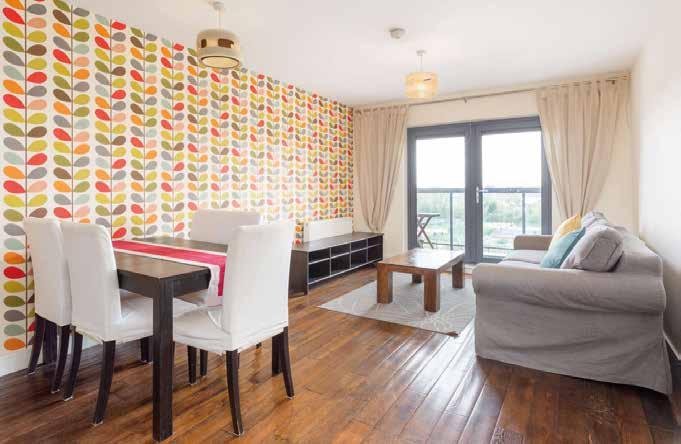
8 minute read
5 Strategies to Save For Your First Home Loan Deposit
Saving money is one of those tricky things in life: we understand how to do it, and often have good intentions, but it’s still a challenge. When you’re looking to buy a home, you need strategies to save money for your home loan deposit. Buying a home is an important milestone and goal that often requires a large initial home loan deposit. So how can you come up with the kind of money that will help you secure your home loan? Below, we outline five strategies to save for your first home loan deposit – strategies that will help make your dreams come true.
Advertisement
PAY OFF YOUR DEBT It may seem counter-intuitive, but paying off debt is actually a strong strategy for saving a big sum of money. You’re probably aware that credit card companies and other debtors charge interest every month that you owe money. What you may not realise is that carrying a low balance on these cards can save you thousands of Euros every year. For most people, paying down cards and other debt all at once is not an option. Just remember that consistently paying the minimum balance due is keeping you in a negative debt loop. The bigger chunks you can pay off at once, the better. Just imagine the hundreds of Euros every month that could be going straight into your savings, instead of to the credit card company’s profits.
GET A ONE-MONTH JUMP START In the last few years, it’s become more popular to dedicate a certain month to being more mindful about spending. It’s sort of like January, when the start of a new year inspires people to eat healthy and get back to the gym. But with this mindset, it could be any month. Having a focused effort around saving for a full month can give you a great head start. November has become known to some as “No Spend November”, when all but the necessities are off the table when it comes to spending. When you add up the savings from not spending on dinners out, gifts, clothing, or travel, you can save a good bit of money in the course of a month.
MINIMISE RECURRING EXPENSES In the age of online payments and auto-pay, it’s easy to lose track of where exactly all of your money is going each month. While it makes sense to have things like your electricity bill automatically withdrawn from your account, there may be lots of other recurring expenses that you don’t think about often, but are a drain on your overall financial picture. Running through your accounts with an eye out for any recurring charges is a great habit to get into so you can manage your expenses more closely. Things like gym memberships, magazine subscriptions, Spotify Premium, and news or other websites that charge for access are all places to look to cut costs. Ask yourself if you really use and need each of these things – and when you answer, think about the big picture. The house you want to save for will likely take priority over a temporary break from your favorite magazine.
SUPPLEMENT YOUR INCOME Bringing in more cash every month is what most people think of when they decide they need to save more. Unfortunately, it can be easier in theory than in practice. If you’re already working full-time or managing your home and family, it might feel impossible to take on even more work. The great news is that today’s gig and freelance-heavy economy offers a lot of opportunities for people to work on their own schedule. If you have a specific skill, you could use your network to book freelance or contract work doing graphic design, writing, or styling. With the right ambition and a little creativity, you can find ways to make some extra cash that works for your schedule.
SET IT AND FORGET IT Of all the things you can do to start saving for your first home loan, the easiest might be to set up a savings system that does the work for you. If you can determine a specific percentage of each paycheck that you can set aside without feeling like your funds are stretched too thin, there are many ways you can automate the process so you don’t miss the money – because you never even see it! Check with your employer to see if there’s a way to designate your direct deposit cheques to be split and placed in different accounts. Putting even 5-10% of your cheque each month into a savings account that you don’t regularly access will have a huge effect over time. In addition, there are apps like Digit that access your account and determine how much you can set aside each week – and automatically place that money into an account for you.
Selling Your First Home:
5 Tips to Getting What You Want
Selling your first home can be an emotional roller coaster. It can be difficult to believe that you’ll ever get what you want from the sale. When you’ve invested time and energy into making your home exactly what you want, it can be hard to imagine someone else calling it home. In addition, you have years of fond memories and positive associations with the first home you purchased and settled into. All that said, there are likely good reasons you’ve decided to sell your home. Whether you need more space, are ready for a change of scenery or neighbourhood, or are in a great market that’s sure to earn you a profit, deciding you’re ready to make the leap is something you won’t take lightly. After you’ve made the decision to sell, the real stress begins. How can you be sure that you’re getting what you want when you’re selling your first home? Below, we outline 5 tips to help ensure you get what you want from the sale of your first home.
INVEST IN KERB APPEAL You know what they say: first impressions are everything. Sellers often make the mistake of believing their home’s interior will impress, while neglecting parts of the home’s exterior. Your home’s exterior forms every buyer’s first opinion of your home, and will inevitably affect how they perceive the value of your home. Before you list your home, consider having a couple of trusted friends drive by and give feedback. And then walk out front yourself and try to see what potential buyers would see if they were approaching the home for the first time. Sometimes, simple fixes like adding a few plants, coating the front door with fresh, bright paint, and making sure all lights are in working order can be enough to spruce up your home from the street level. CONSTRUCT A PRICING STRATEGY Different pricing strategies work better for different situations, but at the end of the day, it comes down to knowing what your home is worth in your market. Do your research and find comparable sales in recent years so your home’s price is grounded (in something other than the amount of money you’d like to make). When you feel you have a ballpark range, one strategy to consider is pricing low. With this approach, you potentially attract a large pool of potential buyers and can negotiate with real power. On the other end of the spectrum, you could price your home higher than market value, with the hope that you’ll ultimately land right around the price that’s right for the market, but still profitable for you.

PLAY TO YOUR HOME’S STRENGTHS When it comes to the interior of your home, things can get overwhelming quickly. Focusing on every detail in every room is the quickest way to lose motivation. Accept that you’ll never make everything perfect, and instead focus on what makes your home truly unique. Maybe you have a fireplace with historic character, or extra large bedrooms that let in great light. Play to your home’s strengths and highlight these areas with lighting or fresh paint or curtains. These visual cues will draw the eyes of potential buyers and keep them focused on the best parts of your home. DON’T MAKE IT PERSONAL
This is your home. You’ve spent years carefully hanging family photos and collecting trinkets that are meaningful to you to fill the shelves. Now that it’s time to sell, it’s also time to strip away these elements that are personal to you so you can help your buyers focus on the home – not the people who have been living in it. GO EASY ON THE UPGRADES It’s tempting to get carried away looking for places to upgrade your home before a sale. A new kitchen or bathroom, or even knocking down a wall might feel like a dramatic way to make a statement and impress potential buyers. There’s no way to make a major upgrade that’s not influenced at least in part by your personal tastes. And while your tastes may be refined and sophisticated, they won’t be everyone’s cup of tea. Instead of investing heavily in something that may not work for every buyer, consider small refreshes instead. A coat of paint and new hardware for cabinets and doors can go a long
way in polishing your home so it’s ready for showings. Your goal is to create an environment that’s warm and welcoming, but fairly impersonal. Each prospective buyer should be able to see themselves in the walls of your home. Stripping out the details that make your home uniquely yours will help each buyer envision their life there – eating dinner at the table and hanging their own photos on the wall. Ultimately, this will not only help close the sale – but also make sure you are getting what you want from the sale.









